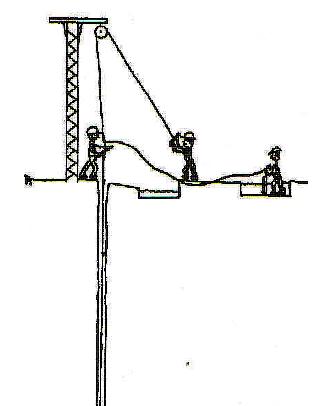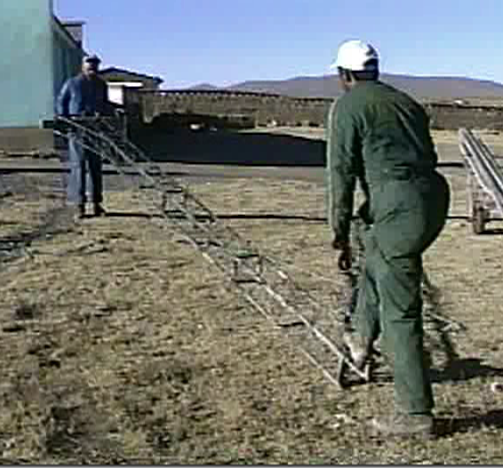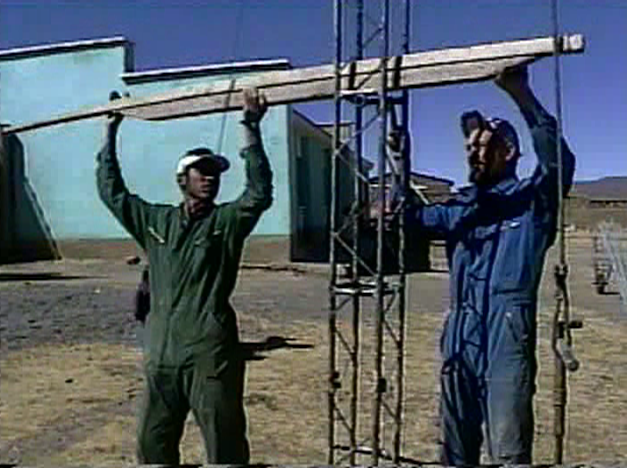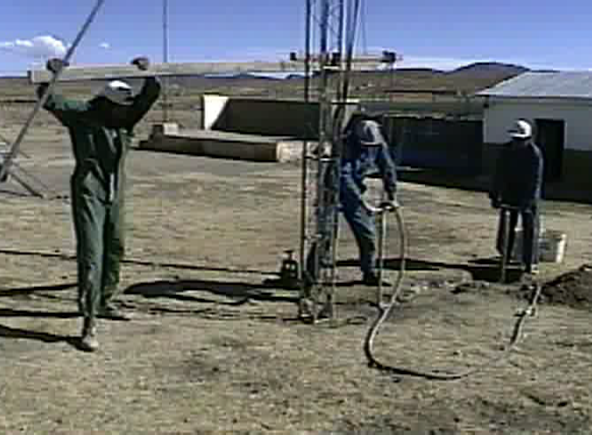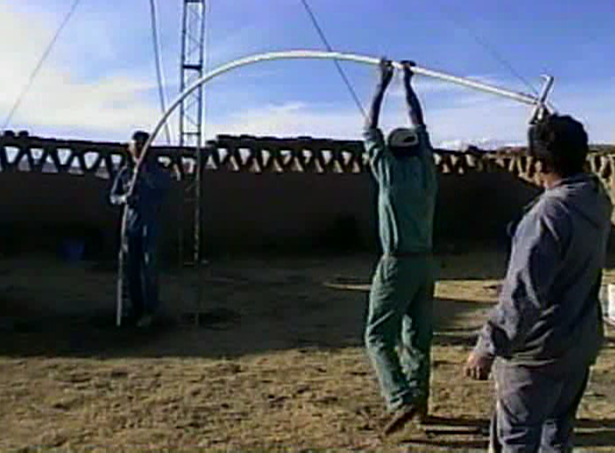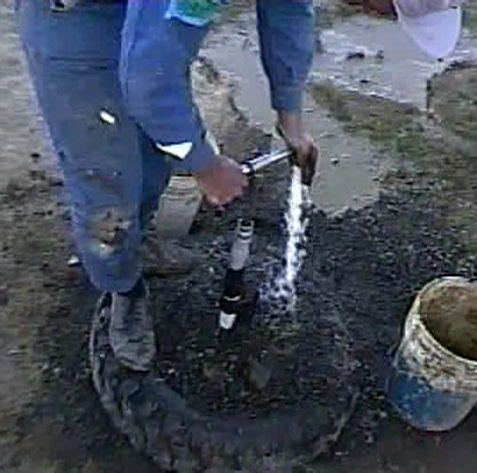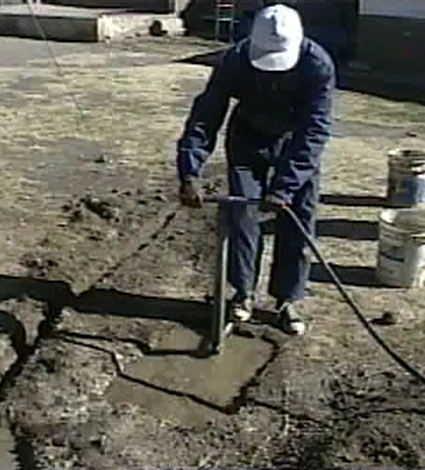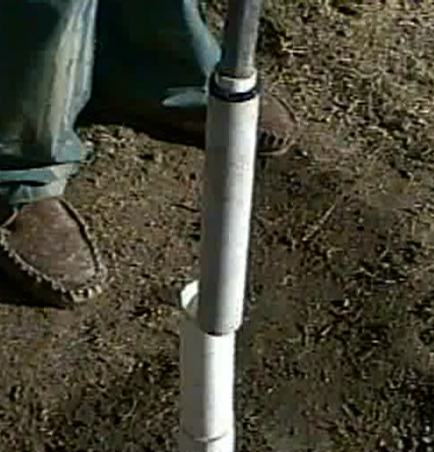水力噴射-EMAS方法
手工鑽井中的EMAS方法是融合了水力噴射、衝擊鑽法以及迴旋式之鑽井技術。此方法需使用手動泥泵,每個行程末端鑽桿皆轉90度;這可鑽鑿到各種鬆土、綜合材料及輕石。但鑽桿無法穿過硬原岩及卵礫石(如:地下的古老河床)。管井直徑一般為37毫米。
EMAS鑽井法是由玻利維亞的Escuela Móvil de Agua y Saneamiento(水與衛生流動學校)所開發。EMAS在玻利維亞的計畫領袖沃夫岡・埃里吉斯・布赫納,於1957年出生在慕尼黑的霍爾茨基興鎮。EMAS建立於1993年,已在聖胡利安(1994年)及裴瑞玆(1997年)的部門培訓了約130位獨立造井師,其中有20位學生從認證過的工藝課程中畢業。玻利維亞的造井師們創立了一個造井師組織。
EMAS建立於1993年,已在聖胡利安(1994年)及裴瑞玆(1997年)的部門培訓了約130位獨立造井師,其中有20位學生從認證過的工藝課程中畢業。玻利維亞的造井師們創立了一個造井師組織。
三個月的訓練過程中,農業工人受訓如何獨立鑽井、建造衛生設施、及在當地社區視需求推廣自己的技術。因鑽井及建造線路系統需要大量投資,所以一直以來難以實現在郊區建造大規模的飲水系統。沃夫岡・布赫納依照當地情況,改建了原本受到大眾接受的吸式及沖洗式鑽井系統。
EMAS不只是水與衛生流動學校的名字,也是整個技術及社會對水和衛生的概念;包含收集雨水、太陽能熱水器、風力發電、液壓頂桿、水處理、小型貯水池與水槽、各式各樣的手泵與腳泵,及鋼筋混凝土貯水池。
適宜條件
僅以人力鑽鑿,不需使用機器可在三至四日內挖掘90公尺深的井。使用EMAS方法則可挖至100公尺。南美大部份的地區(砂壤土)在地質上適合此種EMAS鑽井方法(以沖洗式及吸式鑽井為主)。
此技術適用於凝聚性弱之沙及淤泥;最適用於壤土、綜合材料及輕石。地質為純粗砂的情況下如果只使用沖洗式鑽井,進度會有些緩慢:因為就較狹窄的鑽桿而言,鑽桿及井壁間的空隙相對之下較大而造成水流緩慢向上流,導致鑽井泥漿中的沙下沉速度比上升的快。在此情況下能簡單的以改變把手來將沖洗式改變至吸式鑽井。例子提供於影片內。也有特別設計的萬能鑽頭對吸式及沖洗式皆十分好用,且不會被石頭堵塞。
因為鑽孔會因水壓維持敞開狀態,為防止崩塌,整個鑽井及安裝過程中流體鑽孔需保持滿水狀態。一個20公尺的井,一、二桶水即足夠;或每公尺約10-20公升水。
| 優點 | 缺點 |
|---|---|
| - 在細微至中等沙質中使用起來極快。 - 操作儀器簡單便宜。 |
- 一般受限於砂質土壤及軟黏土。
- 在鑽井工址需有足夠的水可供使用。 |
建造工程、營運及維護
軟黏土最易鑽鑿,在適宜條件之下,以此土質一天內可鑽鑿40公尺。包含清洗的水,每鑽鑿一公尺需10至20公升的水。一個20公尺的井只需一、二桶水即足夠。
鑽井是一項不間斷的作業:在鑽鑿工作完成或被中斷之前,鑽頭通常不能從鑽孔上移除。按照插入鑽桿的比例,固定另一個長3/4吋(19毫米)、有著強化螺紋之金屬管。以手動泥泵將鑽井泥漿(普通黏土的懸浮物或密度適中的皂土所成的泥)經由鑽桿抽空。鑽井泥漿回升時會帶著碎裂的材料。沙及小石頭會沈澱於地上挖的沈澱區域,泥土則會經由泵再循環利用。
衝擊式作業為:以槓桿將鑽頭抬起,安裝在鑽塔上再使其落下。接下來,鑽頭的兩頭各旋轉半圈,加強其研磨作用。
鑽鑿而成的洞直徑約為兩呎,便宜的1又1/2吋(39毫米)聚氯乙烯管則作為井的套管。這能容納1又1/4吋的聚氯乙烯活塞泵。但如有需要,井的上半部(比最低預期水位低一公尺) 可擴大至能容納直徑稍大的泵。
因為整個鑽桿為金屬製,鑽頭的重量會隨著深度線性增加。因此井越深,行程越重 (行程長度被槓桿限制為30公分)。
不需使用臨時套管。越接近理想的深度,以逐漸注射低密度的泥土將鑽井泥漿從洞內移除。但如出現不穩定的分層,此稀釋行為可能造成井在裝套前崩塌。在此情況下,最好在井內先以泥裝套然後澆入或注入水進套管內排空泥土(反洗)。
完整的設備可於當地的任何弧焊工廠建造,材料在一般五金行即可購買。
Costs
An EMAS drilling rig, fit to drill holes up to 30 m deep, can be built in Bolivia for about US$ 600 - 800. This includes the tower, mud pump and all essential non-common tools to operate and maintain it.
In most cases, the tube well is combined with an EMAS hand pump. In that case, the total cost per meter, including labor, materials, hand pump and 1 year warranty, in Bolivia amounts to between 4 and 10 US$. The standard price is between 5 and 6 Dollars per meter.
That price is calculated in 3 parts. Taking 6$ as basis, 2$ are for the material and hand pump (a hand pump is normally included in a well deeper than 20 meters), 2$ are for the wage of the two drillers (including also the maintenance of the equipment) and 2$ in the creation of a reserve fund in case there is no water or not enough water found, salty water found or a drilling mistake is made such as a broken drill stem, the wrong filter sleeve, etc. Normally, for the price of 5$ a 1 year warrantee is given in case that the sand remains after 4 weeks use.
The average well depth in Bolivia is around 27 meters, and costs approx. US$ 180 including an EMAS hand pump. This makes a surface covering supply of drinking water possible for municipalities and families in rural areas.
Field experiences
The EMAS method is mainly used in Bolivia, Panama, Ecuador, Paraguay, Brazil, Peru, Honduras, Nicaragua, El Salvador, Guatemala, Eritrea and Sri Lanka.
Manuals, videos and links
EMAS has produced a set of DVDs which cover, among others, EMAS drilling and other low cost water supply techniques. Contact Wolfgang Buchner in Bolivia at [email protected] or [email protected] if you would like to order a copy of the movies on DVD.
EMAS manual well drilling is a method for drilling small-diameter tube wells by hand. The drilling method is a hybrid between washboring, percussion and rotary drilling. It permits to drill through all kinds of loose soils, as well as consolidated materials and light rock. It will not, however, penetrate hard original rock or boulders (e.g. ancient river beds underground). The usual diameter of the tube well is 37 mm. Movies made by Wolfgang Buchner.
- Collection of EMAS movies on different EMAS subjects.
EMAS method - part 1 |
EMAS method - part 2 |
|
temporary casing - part 1 |
temporary casing - part 2 |
temporary casing - part 3 |
Other resources
- The Technology Demonstration Center EMAS works with EMAS Jetting. See Technology Demonstration Centers
- EMAS on well drilling.
- EMAS drilling by Paul Cloesen.
- Rural Water Supply Network, article on EMAS drilling.
- Akvo solution of the week 10
- Akvo solution of the week 11
Acknowledgements
- This article is based on an article by Paul Cloesen, and on material from emas-international.de


